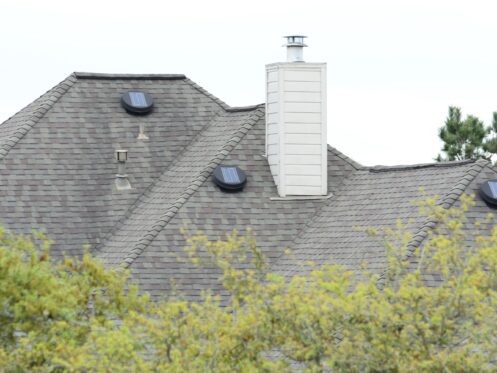Ventilation allows your roof and attic to breathe. Airflow through the attic and under the roof is integral to temperature regulation, humidity control, and energy efficiency. Most homes have various types of passive roof ventilation, such as gable, soffit, ridge, and box vents. Lack of adequate ventilation or damaged vents can mean big trouble. Let’s look at the top indications that something’s wrong with your roof’s ventilation system.
Visible Damage to Roof Ventilation
Homeowners should regularly inspect their roof vents both from the ground and inside the attic. While you may not always be able to spot all issues from the ground, inspecting the attic gives you a closer look at all the vents. Look for signs of wear or damage. Pay close attention to the sealant and flashing at the base of the vents. Missing or shrinking sealant, as well as cracked, dislodged, or rusted flashing, can indicate potential problems.
In addition, check for any vents that may be obstructed by dirt, debris, or even bee and bird nests. These blockages can hinder airflow, impacting your home’s ventilation. To clean them, you can gently remove any visible debris with a soft brush or a shop vac. However, it’s best to contact a professional for any necessary roof repairs, including fixing damaged flashing or replacing seals.
Decreased Home Comfort and Rising Energy Costs
Most homes in the U.S. have passive attic ventilation, which allows the air inside the attic to normalize with the outside air. Thus, the temperature and humidity in the attic should be similar to those outside the home. This natural ventilation helps prevent excess heat buildup in the attic, but insufficient ventilation can negatively impact your home’s comfort and energy efficiency.
When heat builds up in the attic, it can affect your home’s temperature. In summer, if the attic gets too hot, that heat can transfer into the living spaces below, causing the temperature in your home to rise. This forces your air conditioning system to work harder and longer to maintain a comfortable indoor temperature, ultimately increasing your cooling costs. In winter, the opposite can happen. If the attic is poorly ventilated, it can trap cold air even on warmer days, making it harder to maintain warmth inside the home. This causes your heating system to work overtime, increasing energy use and costs as you try to keep your home comfortable.
Upgrading your attic’s insulation can increase energy efficiency in both summer and winter by limiting heat transfer between your living areas and the attic. In addition, you can lower your cooling costs during Charlotte’s sweltering summers by hiring a professional to ensure your attic’s passive ventilation is working as it should. Ridge and soffit vents work together to help regulate the temperature and moisture levels in the attic. Ridge vents are installed along the roof’s peak, while soffit vents are positioned along the eaves. As hot air rises in the attic, it escapes through the ridge vents, and cooler air is drawn in through the soffit vents. This creates a continuous flow of air that helps prevent heat buildup and reduces moisture accumulation in your attic.
You should consider mechanical ventilation options if passive ventilation alone isn’t enough. Powered exhaust fans can enhance airflow in the attic, helping to expel hot air more effectively. Alternatively, whole-house attic fans are particularly effective and can cool your home without the need for air conditioning on milder summer days and in the fall and spring. These fans draw cooler outside air into a home through open windows and exhaust hot indoor air through the attic. Additionally, they can be turned on briefly in the winter to refresh the air in your home. Many models can exchange a home’s air in about 15 minutes.
Shingle Wear and Damage
Asphalt shingles are the most common roofing material in the U.S., but they are susceptible to damage when exposed to excessive heat. One of the early signs of heat-related wear is edge curling. When shingles curl at the edges, it creates gaps that allow wind to lift the shingles and rain to seep underneath. Over time, this can damage the underlayment and sheathing, leading to costly repairs. Curling is often caused by poor ventilation in the attic, which leads to heat buildup on the underside of the shingles.
Shingle damage due to heat is not limited to curling. If the attic lacks proper ventilation, shingles may lose their granules more quickly, leaving bare spots that are more vulnerable to water penetration. Excessive heat can also make shingles brittle, causing them to crack. In severe cases, shingles may even buckle or warp. Having a professional inspect your attic for ventilation issues and implementing any necessary upgrades can prevent shingle damage and help you avoid the need to replace your roof prematurely.
Excess Moisture in Your Attic
Excess moisture in your attic is a serious concern that can lead to significant damage to your home’s structure and affect indoor air quality. Proper attic ventilation is essential in preventing moisture buildup, as inadequate airflow allows humidity to accumulate, creating a host of problems.
One of the most common issues caused by excess moisture is mold and mildew growth. When warm, moist air becomes trapped in the attic, it condenses on cold surfaces, such as rafters, insulation, and plywood sheathing. This creates the ideal environment for mold and mildew to thrive. These fungi not only cause unpleasant odors but can also deteriorate building materials. Additionally, mold spores can spread into the rest of your home, potentially decreasing your indoor air quality and contributing to respiratory issues.
Moisture in the attic can also cause rot, which affects wooden beams, rafters, and sheathing. The moisture can also seep into insulation materials, causing them to lose their effectiveness and become more prone to deterioration. This can lead to costly repairs, including replacing rotting beams and removing and replacing damaged insulation.
Ice Dams
While ice dams are most common in the northern U.S., they can occur in southern climates during cold snaps. When warm air from living spaces below escapes into the attic, it causes the snow on the roof to melt. As the melted water runs down and reaches the colder eaves at the edges of your roof, it refreezes, forming a dam. Ice dams can cause water to back up under the shingles, leading to leaks that can cause water damage to the ceiling and walls of your home. An attic ventilation upgrade can prevent ice dams by venting warm air outside and ensuring your roof does not get warm enough to melt snow after a winter storm.
Contact Your Local Roofers
Since 1994, Blue Fox Roofing & Renovations has been serving the residents of Charlotte, NC, and the surrounding areas. We install, maintain, and repair residential roofs. We can also inspect your attic and roof for proper ventilation and recommend upgrades. Contact us today to schedule an appointment with one of our experienced roofers.




